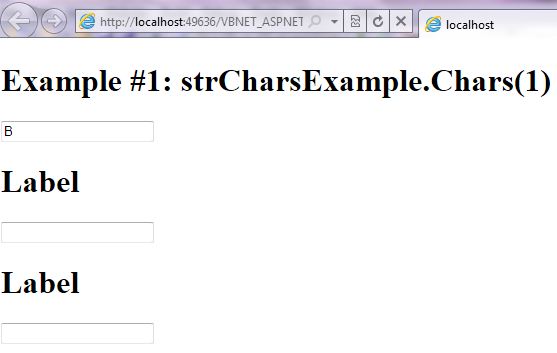VB.NET ASP.NET Chars() Source Code Syntax Example
Posted by asp.net videos on Sunday, February 20, 2011 · Leave a Comment
Premium (Not Free) Video Tutorials
Free Video Tutorials & Free Tools
Premium (Not Free) Video Tutorials
Free Video Tutorials & Free Tools
Chars Example Syntax VB.NET ASP.NET | Chars | Source Code
Summary: – Illustrates using Chars with Source Code Syntax Example in VB.NET ASP.NET.
*** 2. Chars Syntax ***
Purpose:
Gets the character at the specified index – index is 0 based
Syntax:
myString.Chars(index)
| Parameters |
Description |
| myString |
string
|
| index |
valid numeric expression
|
| Result Data Type |
Description |
| Char |
returns the charater at the specified index
|
*** 3. Chars – Quick Example ***
|
Dim strCharsExample As String = “ABC”
TextBox1.Text = strCharsExample.Chars(1) ‘ Returns B
|
*** 4. Chars – Full Example ***
Chars Example Output Screenshot

Step 1: Click on Visual Basic to Cut-n-paste code into Chars.aspx.vb
Imports System
Imports System.IO
Imports System.Data
' This example is from http://idealprogrammer.com
' It shows how you can use Chars syntax in VB.NET ASP.NET
'****************************************************************************************
' Purpose: Gets the character at the specified index - index is 0 based
'
' Syntax: myString.Chars(index)
'
' Parameter1: myString - string
'
' Parameter2: index - valid numeric expression
'
' Result: Char - returns the charater at the specified index
'
' *********************************************************
'
' Quick Example: Dim strCharsExample As String = "ABC"
' TextBox1.Text = strCharsExample.Chars(1) ' Returns B
'
'****************************************************************************************
Partial Class _Chars
Inherits System.Web.UI.Page
Protected Sub Page_Load(ByVal sender As Object, ByVal e As System.EventArgs) Handles Me.Load
Label1.Text = "Example #1: strCharsExample.Chars(1)"
Dim strCharsExample As String = "ABC"
TextBox1.Text = strCharsExample.Chars(1) ' Returns B
End Sub
End Class |
Imports System
Imports System.IO
Imports System.Data
' This example is from http://idealprogrammer.com
' It shows how you can use Chars syntax in VB.NET ASP.NET
'****************************************************************************************
' Purpose: Gets the character at the specified index - index is 0 based
'
' Syntax: myString.Chars(index)
'
' Parameter1: myString - string
'
' Parameter2: index - valid numeric expression
'
' Result: Char - returns the charater at the specified index
'
' *********************************************************
'
' Quick Example: Dim strCharsExample As String = "ABC"
' TextBox1.Text = strCharsExample.Chars(1) ' Returns B
'
'****************************************************************************************
Partial Class _Chars
Inherits System.Web.UI.Page
Protected Sub Page_Load(ByVal sender As Object, ByVal e As System.EventArgs) Handles Me.Load
Label1.Text = "Example #1: strCharsExample.Chars(1)"
Dim strCharsExample As String = "ABC"
TextBox1.Text = strCharsExample.Chars(1) ' Returns B
End Sub
End Class
Step 2: Click on XML to Cut-n-paste code into Chars.aspx
< %@ Page Language="VB" AutoEventWireup="false" CodeFile="Chars.aspx.vb" Inherits="_Chars" %>
< !DOCTYPE html PUBLIC "-//W3C//DTD XHTML 1.0 Transitional//EN" "http://www.w3.org/TR/xhtml1/DTD/xhtml1-transitional.dtd">
<html xmlns="http://www.w3.org/1999/xhtml">
<head runat="server">
<title></title>
</head>
<body>
<form id="form1" runat="server">
<div>
<h1><asp:label ID="Label1" runat="server" Text="Label"></asp:label> </h1>
<asp:textbox ID="TextBox1" runat="server"></asp:textbox><br />
<h1><asp:label ID="Label2" runat="server" Text="Label"></asp:label> </h1>
<asp:textbox ID="TextBox2" runat="server"></asp:textbox><br />
<h1><asp:label ID="Label3" runat="server" Text="Label"></asp:label> </h1>
<asp:textbox ID="TextBox3" runat="server"></asp:textbox><br />
</div>
</form>
</body>
</html> |
< %@ Page Language="VB" AutoEventWireup="false" CodeFile="Chars.aspx.vb" Inherits="_Chars" %>
< !DOCTYPE html PUBLIC "-//W3C//DTD XHTML 1.0 Transitional//EN" "http://www.w3.org/TR/xhtml1/DTD/xhtml1-transitional.dtd">
<html xmlns="http://www.w3.org/1999/xhtml">
<head runat="server">
<title></title>
</head>
<body>
<form id="form1" runat="server">
<div>
<h1><asp:label ID="Label1" runat="server" Text="Label"></asp:label> </h1>
<asp:textbox ID="TextBox1" runat="server"></asp:textbox><br />
<h1><asp:label ID="Label2" runat="server" Text="Label"></asp:label> </h1>
<asp:textbox ID="TextBox2" runat="server"></asp:textbox><br />
<h1><asp:label ID="Label3" runat="server" Text="Label"></asp:label> </h1>
<asp:textbox ID="TextBox3" runat="server"></asp:textbox><br />
</div>
</form>
</body>
</html>
Prerequistes:
- Install Visual Web Developer 2010
- Install SQL Server Express
- Download Northwind and Pubs Databases
- Attach Northwind Database to Databases in Sql Express
- Attach pubs Database to Databases in Sql Express
Notes:
- You can build your own library of syntax examples by using same web site over and over and just add new web forms to it.
Instructions:
- Use Visual Web Developer 2010
- Create new web site;
- Click File/New Web Site
- Select ASP.NET Website Template
- Select Visual Basic for Language
- name of Web Site could be VBNET_ASPNET_Syntax.
- Add New folder named “StringManipulation”
- Right-click project name in solution explorer;
- add new folder;
- name of folder could be: StringManipulation
- Add Web Form Named Chars to StringManipulation folder
- Right-click StringManipulation folder;
- add new item;
- Select Web Form
- Check place code behind in separate file
- Web Form name could be Chars
- Click on Visual Basic in step 1 at the top of this page to copy code into code-behind Chars.aspx.vb
- Click on XML in step 2 above to copy code into web form Chars.aspx
- Right-click on Chars.aspx in solution explorer and select view in browser
|
 Download Source Code for All VB ASP.NET Examples in One Project – source code for hundreds of VB.NET ASP.NET examples neatly organized in a single project.
Download Source Code for All VB ASP.NET Examples in One Project – source code for hundreds of VB.NET ASP.NET examples neatly organized in a single project.
